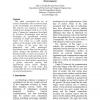Free Online Productivity Tools
i2Speak
i2Symbol
i2OCR
iTex2Img
iWeb2Print
iWeb2Shot
i2Type
iPdf2Split
iPdf2Merge
i2Bopomofo
i2Arabic
i2Style
i2Image
i2PDF
iLatex2Rtf
Sci2ools
HICSS
2008
IEEE
2008
IEEE
Performance of a Wireless Unattended Sensor Network in a Freshwater Environment
This effort investigated the use of wireless unattended sensor network motes in the surroundings of a freshwater lake. The network was required to organize, establish and maintain itself in or on the water. Commercial components developed by Crossbow Technologies were used in developing the experimental networks consisting of single and multiple nodes. Nodes were tested on a solid ground surface, on the surface of the water, below the surface of the water (but not submerged) and fully submerged. Performance metrics based on link quality, parent changes and formation time are presented under a variety of scenarios. It was observed that nodes operating on the surface of the water performed much better than those on a hard surface, operating at a greater inter-node spacing and experiencing fewer parent changes. Submerging one or both nodes had considerable but not overwhelming effects on network performance.
Biometrics | HICSS 2008 | Parent Changes | Sensor Network Motes | Solid Ground Surface | System Sciences |
| Added | 29 May 2010 |
| Updated | 29 May 2010 |
| Type | Conference |
| Year | 2008 |
| Where | HICSS |
| Authors | John C. McEachen, Juan Casias |
Comments (0)

